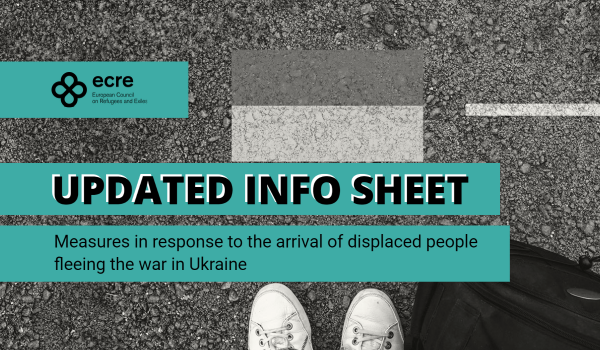ECRE has published the latest update of our non-exhaustive information sheet on EU countries’ responses to arrivals of Ukrainian nationals following the 24 February invasion and the activation of the Temporary Protection Directive (TPD) on 3 March 2022. The information sheet has been regularly updated since March 2022, and the update published today aims to gather information on the implementation of the TPD over the past few months.
As outlined in previous updates, countries such as Germany, Spain, the Netherlands and Luxembourg have chosen to extend the scope of the TPD, whereas countries including Hungary and Poland decided on a limited scope. These decisions have not changed since the last update but official information on how the scope of protection is interpreted and applied is still scarce. Reception arrangements and access to rights are two areas that continue to evolve. Further measures have been taken either extending reception measures for newly arrived persons or creating more sustainable coordinated responses. New centres/facilities have become operational since September 2022 (Austria, Belgium, France, Finland, Latvia, Spain), while a new operational plan has been activated by the EUAA in Bulgaria. Sweden has transferred the competence for reception and accommodation of TP holders to the local municipalities. Issues with reception have been reported in Romania and Poland, particularly with vulnerable individuals. Access to medical, psychological and social services, as well as labour market and education, has been reported to exist in most states but information on the practical situation is not sufficient.
In the previous updates, ECRE had reported the lack of information on how the right to freedom of movement will work in practice. Several states seem now to officially allow the exercise of the right to freedom of movement for beneficiaries of temporary protection (TP) while other countries either do not allow or have not published sufficient information; Hungary is reportedly denying such possibility. Certain countries have published specific information on conditions for travel generally and specifically to Ukraine.
For some states, travel outside the country (including in some cases in Ukraine) is allowed but prolonged absence will result to loss of TP: Austria – for short trips, Switzerland – 15 days in a quarterly period, Norway – beneficiaries must reside in Norway at least 6 months of a year, Netherlands – permissible length of stay might vary depending on country. Other countries mention the possibility but do not seem to set specific time limits, obligations of reporting or other conditions (Bulgaria, Estonia, Czechia, Slovakia). Sweden allows free movement without loss of residence rights but states that financial and housing support may be affected. Italy has clarified that TP holders will receive a special travel document allowing them to travel within the EU. Cyprus allows free movement but if people leave the country definitively, they will lose the protection status and residence. In Finland, persons with temporary protection status who wish to leave the country for a short time should inform the reception centre of their travel plans. If they wish to leave Finland definitively, they must cancel their temporary protection application and upon return they can apply for temporary protection again if they have not applied elsewhere. In Germany, TP holders can apply for transfer of residence if they wish to register as beneficiaries in another Member State.
Returns to Ukraine are also allowed with specific conditions in Croatia (obligation to report to competent local authorities upon re-entry), Luxembourg (for a short time and possibility to assist re-entry unless difficulties arise) and Serbia (advice to inform authorities of travel intentions and duration).

